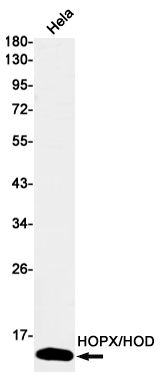
| WB | 1/500 - 1/2000 | Human,Monkey |
| IF | 咨询技术 | Human,Monkey |
| IHC | 1/200 - 1/1000 | Human,Monkey |
| ICC | 1/200 - 1/1000 | Human,Monkey |
| FCM | 咨询技术 | Human,Monkey |
| Elisa | 1/10000 | Human,Monkey |
| Aliases | Hod; Hop; Ob1; Obl; Hdop; Toto; Cameo; AI848177; AW490897; 1110018K11Rik; 1200015P04Rik; 2300002F06Rik |
| Entrez GeneID | 74318 |
| WB Predicted band size | Calculated MW: 8 kDa; Observed MW: 12 kDa |
| Host/Isotype | Rabbit IgG |
| Antibody Type | Primary antibody |
| Storage | Store at 4°C short term. Aliquot and store at -20°C long term. Avoid freeze/thaw cycles. |
| Species Reactivity | Human |
| Immunogen | Recombinant protein of mouse HOPX |
| Formulation | Purified antibody in TBS with 0.05% sodium azide,0.05%BSA and 50% glycerol. |
+ +
以下是3篇与Nucleophosmin(NPM1)抗体相关的文献概览:
---
1. **文献名称**:*Acute myeloid leukemia with mutated NPM1: diagnosis, prognosis and therapeutic perspectives*
**作者**:Falini B, et al.
**摘要**:该研究利用NPM1特异性抗体,通过免疫组化检测急性髓系白血病(AML)患者中NPM1基因突变导致的蛋白异常胞质定位(而非正常核仁定位),为AML的诊断和分型提供关键依据。
2. **文献名称**:*Nucleophosmin: a versatile molecule associated with hematological malignancies*
**作者**:Grisendi S, et al.
**摘要**:文章综述NPM1在血液肿瘤中的作用,强调其抗体在揭示突变蛋白(如AML中NPM1-C阳性突变体)功能及亚细胞定位中的应用,并讨论其作为治疗靶点的潜力。
3. **文献名称**:*Antibody-based detection of nucleophosmin alterations in cancer*
**作者**:Chan WY, et al.
**摘要**:研究开发并验证了一种高特异性抗NPM1抗体,用于区分野生型与突变型蛋白,并应用于肿瘤组织样本的病理分析,证明其在癌症分子分型中的实用性。
---
以上文献均聚焦于NPM1抗体的应用,涵盖疾病诊断、机制研究和临床检测方向。如需具体年份或期刊信息,可进一步补充关键词检索。
Nucleophosmin (NPM1) is a multifunctional phosphoprotein predominantly localized in the nucleolus, where it plays critical roles in ribosome biogenesis, chromatin remodeling, and regulation of cell cycle progression. It also acts as a molecular chaperone, stabilizing proteins like p53 and ARF to influence tumor suppression and stress responses. Dysregulation of NPM1 is implicated in cancers, particularly acute myeloid leukemia (AML), where mutations in exon 12 (NPM1c) cause cytoplasmic mislocalization, serving as a diagnostic marker.
Antibodies targeting NPM1 are essential tools for studying its expression, localization, and interactions. They enable detection of both wild-type and mutant forms via techniques like Western blot, immunohistochemistry, and immunofluorescence. In research, these antibodies help elucidate NPM1's roles in ribosome assembly, centrosome duplication, and apoptosis. Clinically, they aid in diagnosing AML subtypes by distinguishing cytoplasmic NPM1c (mutant) from nuclear wild-type NPM1.
Commercial NPM1 antibodies are typically raised against specific epitopes, with clones like FC-61991 or 376.2 validated for specificity. Their applications extend to monitoring nucleolar stress, evaluating chemotherapeutic responses, and studying viral interactions (e.g., NPM1’s role in HIV-1 replication). Proper validation remains crucial due to NPM1’s post-translational modifications and isoforms. Overall, NPM1 antibodies bridge basic research and clinical diagnostics, advancing our understanding of cancer biology and therapeutic targeting.
×